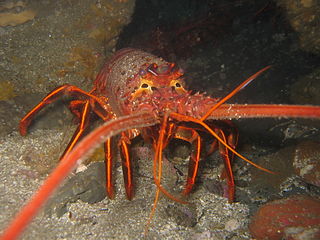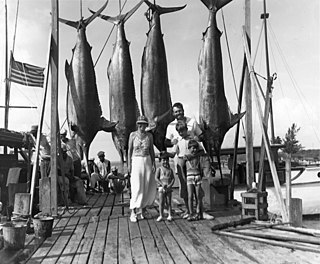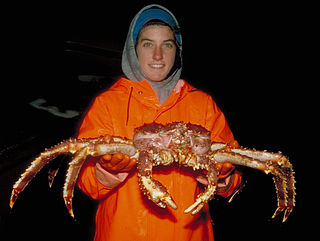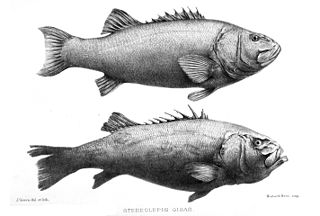Bass is a name shared by many species of fish. The term encompasses both freshwater and marine species, all belonging to the large order Perciformes, or perch-like fishes. The word bass comes from Middle English bars, meaning 'perch'.
Sea bass is a common name for a variety of different species of marine fish. Many fish species of various families have been called sea bass.

The striped bass, also called the Atlantic striped bass, striper, linesider, rock, or rockfish, is an anadromous perciform fish of the family Moronidae found primarily along the Atlantic coast of North America. It has also been widely introduced into inland recreational fisheries across the United States. Striped bass found in the Gulf of Mexico are a separate strain referred to as Gulf Coast striped bass.

Halibut is the common name for three flatfish in the genera Hippoglossus and Reinhardtius from the family of right-eye flounders and, in some regions, and less commonly, other species of large flatfish.

The mahi-mahi or common dolphinfish is a surface-dwelling ray-finned fish found in off-shore temperate, tropical, and subtropical waters worldwide. Also widely called dorado and dolphin, it is one of two members of the family Coryphaenidae, the other being the pompano dolphinfish. These fish are most commonly found in the waters around the Gulf of Mexico, Costa Rica, Hawaii and the Indian Ocean.

Spearfishing is a method of fishing that involves impaling the fish with a straight pointed object such as a spear, gig or harpoon. It has been deployed in artisanal fishing throughout the world for millennia. Early civilisations were familiar with the custom of spearing fish from rivers and streams using sharpened sticks.

The ocean sunfish or common mola is one of the two heaviest known bony fish in the world, the other being the southern sunfish of the same genus. Adults typically weigh between 247 and 2,000 kg. The species is native to tropical and temperate waters around the world. It resembles a fish head with a tail, and its main body is flattened laterally. Sunfish can be as tall as they are long when their dorsal and ventral fins are extended.

The arapaima, pirarucu, or paiche is any large species of bonytongue in the genus Arapaima native to the Amazon and Essequibo basins of South America. Arapaima is the type genus of the subfamily Arapaiminae within the family Osteoglossidae. They are among the world's largest freshwater fish, reaching as much as 3 m (9.8 ft) in length. They are an important food fish. They have declined in the native range due to overfishing and habitat loss. In contrast, arapaima have been introduced to several tropical regions outside the native range, where they are sometimes considered invasive species. In Kerala, India, Arapaima fishes escaped from the aquaculture ponds after the flood in 2018. Its Portuguese name, pirarucu, derives from the Tupi language words pira and urucum, meaning "red fish".

The yellowfin tuna is a species of tuna found in pelagic waters of tropical and subtropical oceans worldwide.

The California spiny lobster is a species of spiny lobster found in the eastern Pacific Ocean from Monterey Bay, California, to the Gulf of Tehuantepec, Mexico. It typically grows to a length of 30 cm (12 in) and is a reddish-brown color with stripes along the legs, and has a pair of enlarged antennae but no claws. The interrupted grooves across the tail are characteristic for the species.

The Mekong giant catfish, is a large, threatened species of catfish in the shark catfish family (Pangasiidae), native to the Mekong basin in Southeast Asia and adjacent China. It is considered critically endangered due to accelerating habitat loss.

The Humboldt squid, also known as jumbo squid or jumbo flying squid (EN), and Pota in Peru or Jibia in Chile (ES) is a large, predatory squid living in the eastern Pacific Ocean. It is the only known species of the genus Dosidicus of the subfamily Ommastrephinae, family Ommastrephidae.

The coho salmon is a species of anadromous fish in the salmon family and one of the five Pacific salmon species. Coho salmon are also known as silver salmon or "silvers". The scientific species name is based on the Russian common name kizhuch (кижуч).

The California sheephead is a species of wrasse native to the eastern Pacific Ocean. Its range is from Monterey Bay, California, to the Gulf of California, Mexico. It can live for up to 20 years in favorable conditions and can reach a size of up to 91 cm (3 ft) and a weight of 16 kg (35 lb). It is carnivorous, living in rocky reef and kelp bed habitats, feeding primarily on sea urchins, molluscs, and crustaceans.

Marlin fishing is considered by some game fishermen to be a pinnacle of offshore game fishing, due to the size and power of the four marlin species and their relative rareness. Fishing for marlin captured the imagination of some sport fishermen in the 1930s, when well-known angler/authors Zane Grey, who fished for black, striped, and blue marlin in the Pacific, and Ernest Hemingway, who fished the Florida Keys, Bahamas and Cuba for Atlantic blue marlin and white marlin, wrote extensively about their pursuit and enthused about the sporting qualities of their quarry.

Alaskan king crab fishing is carried out during the fall in the waters off the coast of Alaska and the Aleutian Islands. The commercial catch is shipped worldwide. Large numbers of king crab are also caught in Russian and international waters.

As with other countries, the 200 nautical miles (370 km) exclusive economic zone (EEZ) off the coast of the United States gives its fishing industry special fishing rights. It covers 11.4 million square kilometres, which is the second largest zone in the world, exceeding the land area of the United States.

The ocean whitefish, also known as the ocean tilefish, is a species of marine ray-finned fish, a tilefish belonging to the family Malacanthidae. It is native to the eastern Pacific Ocean.

Stereolepis is a genus of marine ray-finned fish from the family Polyprionidae, the wreckfish, which is native to the Pacific Ocean.




















